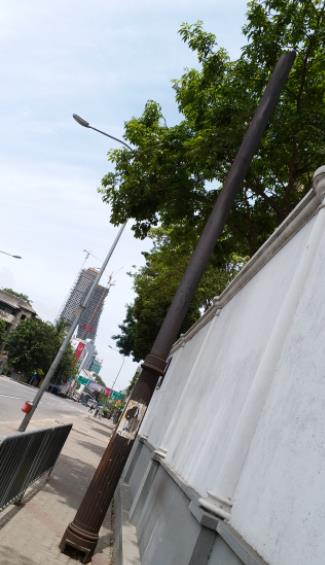(MENAFN- NewsIn.Asia)
By Dr. Lopamudra Maitra Bajpai/newsin.asia
Ruins or remains of material culture in urban areas help us reconstruct important historical episodes. Telegraph and electricity ruins across the British colonies are a witness to the gradual evolution of the system of communication. Roads built or renovated across colonial Ceylon also have fascinating stories to tell.
Thus, a close study of the many cast-iron ruins of electric and telegraph poles strewn across Colombo city and beyond not helps highlight many aspects of demography and science of colonial Ceylon and helps us recreate a map of colonial roads.
Subscribe to our Telegram channel for the latest updates from around the world
A ruin of a cast-iron electricity pole stands near the University of Colombo gate on Bauddhaloka Mawatha. A generous cover of massive trees protects this pole from the elements. Whlie this one is protected by nature, others in Bambalapitiya, Duplication Road and Rosmead Place have been affected by the ravages of time and the weather. There is a half-severed cast-iron pole outside Defence Services College near Kew Street (entrance gate 'C'), and a grand and well-preserved one stands opposite Colombo National Museum.
But well-preserved examples are rare. Nevertheless even the ones in a decrepit condition give us an idea of what they looked like in their time.
The pattern of the cast-iron structure is uniform, with the pole divided into three prominent parts. The base has a square platform, followed by the middle section having a corrugated appearance. The top is cylindrical and smooth.
READ: Lonely plant names 10 best beaches in Sri Lanka
Public electric supply came to Colombo in 1895 thanks to Messrs Boustead Bros. But the business was soon taken over by the United Planters Co. The latter extended the supply in 1899 to build the Colombo electric tramways. The electric poles helped connect important sections and cross-sections of roads.
The manufacture of lamp posts in the late 19th century and early 20th century was an important part of the electric supply system. The lamp posts were decorative. The one in Matale town is truly a work of art.
![]()
With electricity came the telegraph. There is a well preserved telegraph pole near the French Embassy in Rosmead Place. The manufacturer's name, Ham Baker & Co. Ltd can be read clearly in the base on a rectangular plaque. There is another well preserved one outside the main entrance of Durdans hospital. Near the bottom of the pole on a rectangular plaque is the legend Ham Baker & Co. Ltd. Makers Westminister, England. The cast iron poles in Doric style are scattered across Colombo.
The Ceylon Telegraph Department dates back to 1857, the year in which the“Ceylon Government took the preliminary steps for establishing communication between various parts of the island. The first line actually was constructed between Colombo and Galle across a distance of 74 miles.” (Twentieth century impressions of Ceylon- first published in 1907 and edited by Arnold Wright). In the initial days- the poles were made of the trunks of coconut trees. But other options were soon considered as coconut trunks fell victim to torrential rains and rampaging elephants.
The second telegraph line was laid between Colombo and Kandy in June 1858, followed by a 250 miles long line between Colombo and Mannar and Talaimannar, thus providing direct telegraphic communication link with India. Soon, the“Colombo to Madras over 600 miles of wire” came up. Several other places such as Dambulla, Anuradhapura, and Batticaloa were also connected. The line and polls crossed rivers, mountains ,towns and villages across the island.
Interestingly, in July 1880, all the lines in the island were transferred from the Government of India (which had hitherto controlled them) to the Ceylon government. By 1900, there were nearly 1,500 miles of telegraph posts in Ceylon.

Cast iron poll on Kew Street, Colombo 2
Paul Fletcher in his Communicating Empire: Gauging Telegraphy's Impact on Ceylon's Nineteenth Century Colonial Government Administration (PhD dissertation, University of Heidelberg) says:“In addition to its local expansion, the network functioned significantly as a node in the empire's system of global communication, operating as a conveying station and communication mid-way point between the empire's eastern colonies and the Middle East; as the rest of the empire's network expanded, so too did the dimension and capacity of Ceylon's.”
However, Fletcher adds sadly:“The telegraph poles which once lined the island's meandering roads, have been felled since the 1980s. Those that do remain are nothing more than wooden posts, stripped bare of their once buzzing wires.”
(The featured image at the top shows the manufacturer's name at the base of a cast iron telegraphic poll on Bauddhaloka Mawatha, Colombo 7) (The writer Dr. (Ms.) Lopamudra Maitra Bajpai is a Research Grant Fellow, India-Sri Lanka Foundation, and a former Culture Specialist at the SAARC Cultural Center in Colombo)
For similar articles, join our Telegram channel for the latest updates. – click here
MENAFN17022022000191011043ID1103719215
Legal Disclaimer:
MENAFN provides the information “as is” without warranty of any kind. We do not accept any responsibility or liability for the accuracy, content, images, videos, licenses, completeness, legality, or reliability of the information contained in this article. If you have any complaints or copyright issues related to this article, kindly contact the provider above.